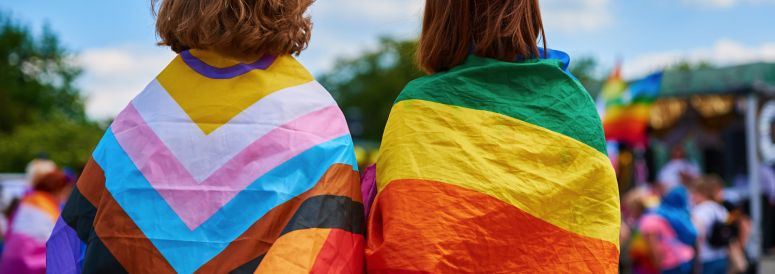Is there a link between neurodivergence and the LGBTQ+ community?
There has been an ongoing discussion on the overlap in neurodivergent and LGBTQ+ communities with studies aiming to give us better insight into the link. Is this link important and what can it do for the support made available to people within each group?
As we observe Pride month, we explore the topic and as offer our insight into how it should inform care.
Table of contents
- What is meant by LGBTQ+?
- What is neurodivergence?
- Shared experiences
- Does science support the link between neurodiversity and being LBGTQ+?
- Why is this important to us?
What is meant by LGBTQ+?
LGBTQ+ is an umbrella term that stands for Lesbian, Gay, Bisexual, Transgender, Queer or Questioning, with the “+” representing a wide range of other identities related to gender and sexuality.
Being LGBTQ+ means that someone’s sexual orientation (who they’re attracted to) or gender identity (how they experience and express their gender) is different from those who are heterosexual (attraction to the ‘opposite’ sex or gender) and cisgendered (those whose gender identity and assigned sex match). This can include people who are pansexual, asexual, nonbinary, genderfluid, intersex, and more. People can also experience a combination of LGBTQ+ identities.
What is neurodivergence?
Neurodivergence is a term that describes brains that work differently from what's considered “typical” or “neurotypical.” It includes a wide range of neurological differences, such as:
- Autism
- ADHD (Attention Deficit Hyperactivity Disorder)
- Dyslexia
- Dyspraxia
- Tourette’s syndrome
- Sensory processing differences
Neurodivergent people may think, learn, communicate, or experience the world in ways that don’t align with expectations, with huge diversity in individual experiences.
Learn more about neurodevelopmental conditions such as ADHD or Autism.
Shared experiences
In many ways, the experiences of being neurodivergent and being LGBTQ+ share common ground - especially when it comes to navigating identity which goes against societal expectation.
Neurodivergent people may experience the world differently and, as a result, have been found to show greater questioning and rejection of conformity to social norms. This desire to self-examine and form an individual perspective is similar to the experience of many LGBTQ+ people who often have to examine their own feelings and identities.
This questioning of norms can open up a space where identity is explored with honesty and depth. With this considered, it makes sense that many neurodivergent individuals find themselves open to fluid understandings of gender and sexuality.
Does science support the link between neurodiversity and being LBGTQ+?
Research supports what many people have long suggested: there’s an overlap between neurodivergence and identifying as LGBTQ+. Autistic and ADHD individuals especially are more likely to identify as LGBTQ+, including as bisexual, asexual, nonbinary, and transgender.
In the case of sexuality, studies have found that autistic people are eight times more likely to identify as asexual or with an ‘other’ sexual orientation, and less likely to identify as heterosexual, compared to nonautistic individuals. Autistic males are more likely to identify as bisexual than nonautistic males, while autistic females are more likely to identify as homosexual than their nonautistic female peers.
Where gender identity is concerned, studies have found that transgender and gender-diverse individuals were three to six times as likely to be autistic than cisgender individuals. Transgender and gender-diverse individuals also had elevated rates of ADHD, bipolar disorder, depression, OCD, learning disorders, and schizophrenia compared to cisgender individuals.
Why is this important to us?
When assessing the care needed by a person, it is important to understand their unique challenges and experiences, including those outside of neurodiversity. Understanding overlaps such as these can be helpful in informing what resources are available and what professionals may need to be more aware of. We don’t need to know an exact scientific cause for the overlap, but acknowledging it is a first step towards offering more inclusive care.
In the case of LGBTQ+ and neurodivergent groups, both communities already face higher rates of anxiety, depression, and discrimination that can lead to trauma. When someone belongs to both groups, those risks can increase. Making an effort to hide differences when accessing care can take its own toll on mental health over time, so support that affirms both aspects of a person’s identity is essential.
Related articles
Should I get an autism assessment?
How do I know if I have depression? 6 signs you should know about
Clinically reviewed
- Leanne Cooper-Brown

